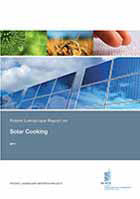Patent Landscape Report on Solar Cooking
Publication year: 2011
DOI: English

This patent landscape report seeks to provide a comprehensive overview of available technologies that exclusively use solar energy as the primary energy source for cooking or pasteurizing food. At the same time it identifies systems that are simple and easy to use in environments of rural communities; preferably systems that could be used in individual households. The report provides a description of the patent search methodology and evaluation of the results, showcasing the tools for accessing and using patent information. It clusters the available technologies in four categories based on the main heating methods used.
- Topic: Climate change / Energy
Solar cooking provides a very cost-efficient and environment-friendly cooking, baking and pasteurizing solution, simple, safe and most convenient foremost to rural communities of developing countries.
The report seeks to provide a comprehensive overview of available technologies that exclusively use solar energy radiation as the primary energy source for cooking or pasteurizing food without consuming any other traditional or alternative source of energy. At the same time it identifies systems that are simple and easy to use in environments of rural communities, preferably systems that could be used in individual households.
Additionally, a product search/market research based on the retrieved patents and the major assignees was conducted in order to explore whether certain patents were linked to commercialized products, resulting in the identification of 18 commercial solar cooking products.
The report provides a description of the patent search methodology and evaluation of the results, showcasing the tools for accessing and using patent information. It clusters the available technologies in four categories based on the main heating methods used (reflected concentration, trapped heating, indirect heating and direct solar absorption) and it includes an extensive statistical analysis showing the trends in patenting activity in the area of solar cooking (over time, geographical distribution, major assignees etc.).